


ATTU’S LORAN SCRAPBOOKS
Ardon Smith, Theodore Point, 1946 - 1947
Originally Published: 01/02/2002

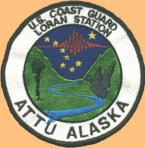
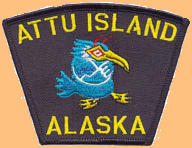
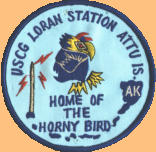
Updated: 12/07/2016 09:50
The year was 1943. The Allied Forces had taken Attu from the Japanese in a bloody battle from
May 11, 1943 to May 29, 1943. About 5000 Japanese had evacuated Kiska on the sly about July
28, 1943 just before a task force of 100 ships and amphibious units carrying over 34,000
troops invaded Kiska only to find the island deserted. At MIT (Massachusetts Institute of
Technology) a Long Range Aid To Navigation (LORAN) system was being readied for
deployment in the Pacific region. Stations were first constructed on St. Paul Island and St
Matthews Island in the Bering Sea and on Umnak Island in the Aleutians. The next stations
were to be constructed on Adak, Amchitka, and Attu in the Aleutians. LORAN was classified as
"Top Secret" and would be used to provide position information for ships and aircraft on
bombing missions and future attack on Japan.
A Liberty Ship, the SS George Flavel left Seattle on October 20, 1943 with the construction
material and personnel to build and man the stations. US Coast Guard Construction
Detachment #26 was assigned to build the stations along with the help of the men that would
be assigned to the stations. The Attu LORAN Station (CG Unit 62) was built on Theodore Point,
the southernmost point on the island. The building material was off loaded at the US Naval
Base at Massacre Bay, Attu. From there is was transported by landing craft, the CG Cutter
Clover, and barges to a landing site called Baxter Cove, several miles from the building site.
Bad weather hampered the operation but after several attempts the material was brought
ashore on December 24, 1943. A road was constructed and material transported to Theodore
Point on a huge sled over the frozen tundra.
The LORAN equipment was loaded onto the SS McKenzie in Seattle and after several stops en
route, arrived at Massacre Bay, Attu in December 1943. On January 15, 1944, construction was
completed and the LORAN equipment installed. The station went on the air for testing and
became operational on February 15, 1944. At the same time the Master Station at St Mackarus
Point, Amchitka had completed testing and became fully operational which completed the
master/slave station requirement. Attu was the Slave station and Amchitka the Master station.
The Attu station consisted of five large Quonset huts, some longer than others, placed in the
shape of an "H" with connecting passageways. One was the galley and mess deck, one the
recreation room and generators, one the C.O.'s quarters, armory, and storage area, one the
crews quarters and pharmacy and the center hut had water tanks, freezers and dark room.
LORAN’s radio shack was separate and about 100 yards toward the point. There was a board
walk with safety line between the quarters and the LORAN radio hut.
The original 1944 crew was Lt Ed Doster, CO; Chief Hoover EXO; Vic Sirwinski, Roy Turner, Ed
Oshushek, Joe Costa, Tom Ohlendorf, Burke Bodwell, Cook Peterson, Cook Stuart, Motor
Mach Eckis, Motor Mach Gary Mohr, Carpenter Ralph Bellamy, Loran operators John Swan, L
C. Davis, Orville Morris, Roy Luckhardt, Stuber, Bob Yeaton, Ned Zenger, Ken MacDonald, Doc
O'Donnell, Arky Moore, John Mitchum and Les Marten son. The tour of duty was supposed to
be about 1 year and most of the original crew departed about December 1944. The 1944-45
crew consisted of Lt Jg George Orford CO, BM Schneider, Fred Weddleton, Everett Esty, Bruce
Wyrick, James Trusty, Sam Baseel, Allen Cooprider, Ancel Dinwiddie, Ed Weber, B.H. Miller, Art
Sanford, Ken Benson, Pauley, John C Francis, Doc Watt, Bill Cole, Eldie, Phillips and Doyal
Sanders. The 1945-46 crew was Lt Jg Ziemien CO; Al Visnauskis, Dick Griessel, Norman
Williams, Fred Pickering, Al Moser, Floyd Pace, Bruce Garfield, Hugh Brittain, Wilton Lisk,
Chester Skowron, J. P Strickland, Don Procter, Gene Schnesky, Lin Cubbison, Len Kaluza,
George Peddicord, H. Morgan Smith, Bob Hanna, Doc Whitney, John C Craig, Billy McCord,
Julian Skiles, Morten W Meyers, Phil Giles, Hank Nachorny. The 1946-47 crew was Lt Jg Ron
Lineburg, CWO James Meade, Lt Jg James H. B. Morton, Hollis Peden, Hank Selasky, John
Barago, Don Funk, Higgins, Gordon Decato, Herb Stearnes, Walter Faron, Bill Mathias, Walter
Baum, George Reeley, Ardon Smitty Smith, Norm Saad, Brooks Talley, Jimmy Yandle, George
Nehring, Robert McMaster, Dutch Van House, Doc Brown. The 1947-48 crew was Lt Jg Burton
V Weston CO, Lionel Vandergrift, Nicholas Borgia, William Mataftin, Red Clements, Jim
Poradek, Allen, McDonald, and Mack Burton.
Travel from Attu’s Massacre Bay enclave to Theodore Point’s LORAN station was hampered
by the presence of a small river, waist deep in depth, flowing between Massacre Bay and
Theodore Point. Few would travel by foot between the two locations.
Newly assigned members to the Coast Guard’s LORAN site at Theodore Point would be first
transported to Massacre Bay (Navy Town, Marine Town, Army Town area) where they would
spend up to a week or so prior to being transported by tug or other small boat down to
Theodore Point, then brought ashore via a dory to the LORAN Station. An area had been
blasted through the rocky shoal shoreline to create a safer and more accessible docking area
for the dories and the men assigned to Theodore Point.
Due to high winds that often swept across the Point, the men would hold on to a safety line
when walking from barracks Quonset huts to either the LORAN Radio Shack which was about
100 yards away or to the docking area.
A transport system had been constructed which consisted of a cart powered by a winch that
would tow the cart via a rope from the docking area up the hill and back to the base camp.
Sometimes it worked. When it didn’t, it was a difficult walk to say the least.
Fuel and heating oil was supplied to Theodore Point’s LORAN Station utilizing 55-gallon drum
containers which would be dropped into the water from Massacre Bay barges near the
docking area. They would then be pushed ashore by CG men wading in the water guiding the
drums to shore. These drums would then be pushed up the hill by the men to their base camp.
Food was plentiful and well-prepared by a trained chef (cook). I remember eating lots of SOS
(a favorite) made using chipped beef or on occasion even with plain old hamburger, as well as
plenty of Spam…a favorite of mine to this day.
An unforgettable event occurred during my tour of duty at Theodore Point. Our Warrant
Officer’s wife was stricken by cancer, whereupon the WO applied for and received permission
to return home on emergency leave to tend to his wife. The problem was to get the WO from
the camp to the tug sent down from Massacre Bay which was to transport him back to
Massacre Bay where he would catch either a ship or plane back to the lower 48. Somebody
was going to have to transport the WO via the dory to the tug. The seas were treacherous,
nobody really wanted to make that trip! Finally, myself and two others volunteered, and off we
went. We managed to get the WO to the tug, then took on some supplies for camp, including a
few turkeys and some new movies. As we approached the makeshift docking area our dory
was swamped…overturned…dumping our crew and supplies into the water…including the
movies. We managed to make it safely back to shore, wading in the water to dry land. We were
soaked, lost our shoes, and had to walk the distance from the docking area back to our
camp…in the snow. While the food was lost, we managed to later snag the cans of film, seen
10’ underwater, using a long pole with a hook on the end, retrieved and brought the film back
to camp, where we soaked the film…which was drenched in sea water…for several days in a
container of clean water. We then dried out the film…thus rescuing the movies. I recall we
would watch the same movie several times, over and over, waiting for new movies to arrive.
Of the hundred plus men who served on Theodore Point, there were 40 still alive as of 10-24-
2002, 20 known deceased, and 40 that we have not located, probably most are deceased. Of the
survivors, we have a reunion every two years starting in 1996, 1998, 2000, 2002, the last one was
in Chattanooga, TN in September of 2002. For further information on the Theodore Point LORAN
Station, please contact:
Ardon "Smitty" Smith at ardons@comcast.net.
Note: Some claim Theodore Point to be Station #62. Ardon believes it may have actually been assigned as Station #64.
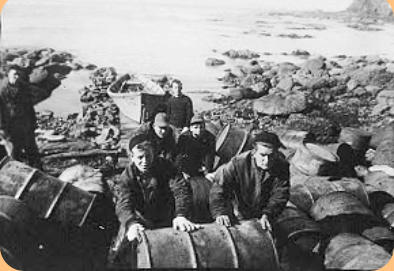
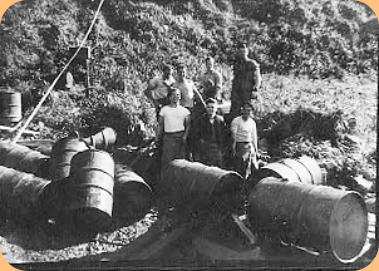
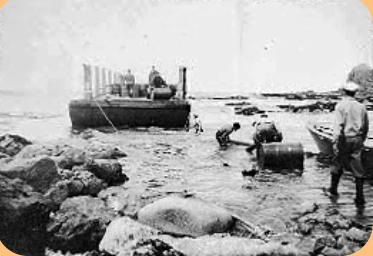
“Some of the first 600 oil drums we brought ashore. It was hell!”
( Photo Source: Loran-History )

Attu’s Theodore Point LORAN-A Station